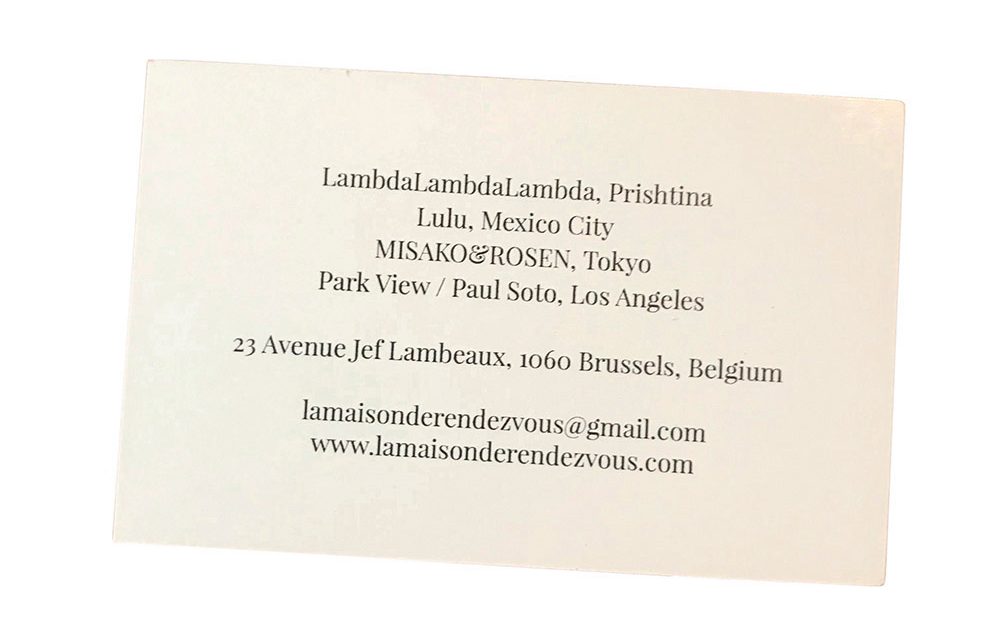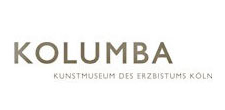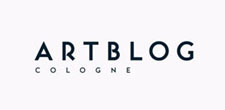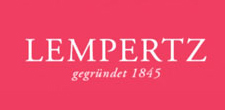EDITORIAL # 45
LA MAISON DE RENDEZ-VOUS

Vier internationale Galerien haben sich zusammengeschlossen und im Januar 2019 LA MAISON DE RENDEZ-VOUS eröffnet – ein Ausstellungsraum in Brüssel, der gemeinsam von LambdaLambdaLambda (Priština), Lulu (Mexiko-Stadt), MISAKO&
ROSEN (Tokio) und Park View/Paul Soto (Los Angeles) geleitet wird. Bezugnehmend auf den Roman La Maison de Rendez-Vous von Alain Robbe-Grillet, werden in den Räumlichkeiten wechselnde künstlerische Positionen gezeigt, die aus den inhaltlichen Bezugspunkten und Verbindungen der teilnehmenden Galerien entstehen.
Eine engagierte Initiative, die Dialoge schaffen möchte und Austausch wie Wechselwirkungen und -bezüge generiert, gleichzeizig jedoch beabsichtigt, eine synthetische Schnittstelle und ein sich öffnendes Ausgangsprogramm zu bieten, das eine Brücke inmitten der lebhaften Kunstszene Brüssels schafft.

Wo haben Sie sich kennengelernt?
Chris Sharp (Lulu): Wir sind uns an ganz verschiedenen Orten und zu verschiedenen Zeiten begegnet, aber erst an dem Wochenende bei der arteBA 2017, bei der ich einen Teil der Ausstellung kuratierte und LambdaLambdaLambda, Park View/Paul Soto und MISAKO&ROSEN eingeladen hatte, haben wir viel Zeit miteinander verbracht, und da ist eine gewisse Bindung entstanden.
Paul Soto: Unsere Freundschaft hat sich weiterentwickelt, wo immer wir uns auf der Welt auch begegnet sind. Meistens bei Messen, was dann stets den Dialog über neue Arbeitsweisen angestoßen hat.
Können Sie einen spezifischen Moment nennen, in dem das Konzept entstand, zusammen eine Galerie in Brüssel zu eröffnen?
MISAKO&ROSEN: Gegenwärtig sind atypische Ansätze für den Betrieb einer inter-
national tätigen Galerie erforderlich, vor allem dann, wenn sie aus anderen Motiven heraus arbeitet als dem der unmittelbaren Profitmaximierung. Das ist kein Wunschdenken. Vielmehr eine Geschäftsstrategie, die – anders als die momentan vorherrschende – davon ausgeht, dass Kunst gewisse Eigenschaften besitzt, die tatsächlich genau solche atypischen Ansätze erfordern, um langfristig Unterstützung innerhalb der Kultur zu finden.
Als Galerie, die – was den geographischen Ort und die Finanzstärke angeht – am Rande der Kunstwelt arbeitet, wünschen wir uns ganz besonders, uns an kooperativen Projekten zu beteiligen. Das Brüsselprojekt ist beispielhaft für die Art von Initiativen, an denen wir partizipieren wollen.
Vor diesem Hintergrund – wir haben uns auf ein konventionelles Modell verpflichtet und priorisieren die Ausstellungen, die wir in unseren Räumen in Tokio präsentieren – ist es eine Erleichterung, tatsächlich einen Ort in Brüssel zu haben, an dem wir einen alternativen Ansatz zum Kunsthandel praktizieren können.
Paul Soto: Es gibt das Bedürfnis, jenseits der ortsgebundenen Galerie- und Kunstmessenmodelle Arbeitsweisen ohne die Tendenz zur Expansion zu finden. Die Zusammenarbeit im Rahmen komplementärer Sensibilitäten bietet uns die Möglichkeit, in unseren Programmen Raum zu schaffen, ein neues Publikum zu finden und ein neues Gespräch mit langfristiger, anhaltender Wirkung in Gang zu bringen, ohne die nötigen Ressourcen, um das alleine zu machen. Die Haltung in Brüssel und in der Brüsseler Kunst-Community scheint zu der Kohäsion und Offenheit zu passen, die dieser Ansatz braucht, wenn er Eindruck machen soll.
LLL: Der spezifische Impuls bestand darin, dass sich alles von selbst ergeben solle, ohne allzu konstruiert zu sein. Es ist heute sinnvoller denn je, offen für Experimente zu sein, statt sich an altmodische Methoden zu klammern, nur weil das sicherer scheint.

Wie erleben Sie Brüssel und wie reagiert Brüssel auf LA MAISON DE RENDEZ-VOUS (LMDRV), auf Ihr Konzept und Ihr Programm?
MISAKO&ROSEN: Die anfängliche Reaktion auf das Projekt „vor Ort“ war begeistert. Um bei Kunstsammlern bekannt zu werden, braucht es mehr Zeit – was zu erwarten war. Ähnlich Initiativen wie CONDO, die sich ihre Galerieräume teilen, geht es bei unserem Projekt auch darum, die Aufmerksamkeit auf die Ausstellung statt auf den Stand auf der Kunstmesse zu lenken, und es ist nur natürlich, dass es nach einem Jahrzehnt des auf Messen fokussierten Sammelns … es wird Zeit brauchen, um Sammlern bei der Neuorientierung zu helfen.
Paul Soto: In Brüssel hat man das Gefühl, in einem Kaleidoskop zu leben, was die Energie angeht, und das ist spannend und ein bisschen anders als in anderen Hauptstädten. Trotzdem gibt es auch gewisse Spannungen, Gentrifizierung und steigende Mieten, Einwanderung und Rassismus, die vielleicht noch sichtbarer sind als Entwicklungen, die man an anderen Orten spürt (man schließt die Augen und schon steht da ein neuer Wohnturm). Das scheint einen Einfluss darauf zu haben, wie Künstler und Praktiker ihre Arbeit angehen. Ich glaube, das hat auch etwas mit unserem Ansatz hier zu tun.
LLL: Wir haben Glück gehabt, dass wir in Brüssel so gut aufgenommen wurden. Obwohl die Kunstszene in der Stadt nicht leicht zugänglich scheint, läuft für uns alles in eine gute Richtung. Weil die Stadt unter anderem den Vorteil hat, sich dem Hype zu widersetzen, können wir eine langfristige, gesunde Beziehung zu Kuratoren, Sammlern und Künstlern aufbauen.
Beschränkt sich die Zusammenarbeit auf Ihre Räume in Brüssel oder haben Sie umfassendere Pläne für eine Kooperation?
Chris Sharp: Die ursprüngliche Idee war es, im LMDRV zusammenzuarbeiten, aber inzwischen kooperieren wir auch auf Kunstmessen. Bei der Art Brussels 2019 sind wir als LMDRV aufgetreten und wollen das auch 2020 wieder tun. Es könnte andere, ähnliche Kooperationen geben. Und natürlich gibt es eine wachsende Offenheit für die gemeinsame Präsentation und Ausstellung von Künstlern.
Paul Soto: Die Kooperation erstreckt sich auf WhatsApp, E-Mails, Treffen in anderen Städten – allgemeiner Informationsaustausch, der wesentlich ist für eine dauerhafte fruchtbare Zusammenarbeit und Freundschaft – auch für Zeiten der Verletzlichkeit. Es gibt die Kunstmessen, aber auch Andeutungen weiterer Möglichkeiten für Formate, Orte, Leben für das Projekt.
LLL: Seit der ersten Vernissage bei LMDRV hat die Kooperation die physischen Räume der lokalen Galerie bereits überschritten.

Der Kunstmarkt verändert sich gerade sehr stark. Können Sie die weitreichendsten Veränderungen für sich und Ihre Galerie nennen?
MISAKO&ROSEN: Wir mussten uns sehr viel stärker mit der unmittelbaren Umsatzseite des Geschäfts beschäftigen.
Paul Soto: Weniger Interesse an Galeriebesuchen und diesem Modell der Kontemplation und mehr Interesse am Austausch von Bildern und reiner Information. Das hängt alles mit neuen Formen der Aufmerksamkeit und des Kapitalismus zusammen.
Wie wichtig ist Ihre eigene Galerie, sind die Ausstellungen, die Sie dort präsentieren, und die lokale Szene?
MISAKO&ROSEN: Wir hätten keine Identität, wenn wir nicht in unserem lokalen Kontext verwurzelt wären. Das Hauptziel bei der Entwicklung unseres Programms war es, Künstler aus Japan und dem Ausland miteinander ins Gespräch zu bringen. Und in Ermangelung einer institutionellen Unterstützung für zeitgenössische Kunst spielt unsere Ausstellung hier zu Hause eine wichtige Rolle.
Paul Soto: Die Galerie ist an die Community gebunden, in der wir leben. Sie beteiligt und unterstützt Künstler, die kameradschaftlich mit uns arbeiten. Wir alle brauchen uns gegenseitig, und Künstler brauchen immer Ausstellungen, um Ideen und Aussagen in einem kontemplativen Rahmen zu präsentieren. Die Galerie besteht nur dank ihres verankerten Ausstellungsmodells, das eine besondere Sensibilität und einen Standpunkt bietet, der von den Gegensätzen erzeugt wird.
Chris Sharp: Lulu ist zwar in der Programmgestaltung sehr international, reagiert aber unmittelbar auf den lokalen Kontext. Wenn wir einen Künstler zu einer Ausstellung in Mexiko-Stadt einladen, fragen wir uns immer, wie diese Ausstellung die lokale Szene beeinflusst, welche produktiven Spannungen sich entwickeln werden und inwieweit das Werk verständlich ist. Das sind wichtige Faktoren bei der Festlegung des Programms. Und angesichts der mexikanischen Sensibilität für Fragen der Nationalität, berücksichtigen wir diese entsprechend. Man kann zum Beispiel nicht einfach einen Haufen Gringos in Mexiko zeigen. Wir stellen Künstler aus aller Welt aus. Und obwohl Lulu stark mit meiner persönlichen Geschichte und meinen Reisen als Kurator verbunden ist, wäre es in einem anderen Kontext nicht dasselbe.
LLL: Der lokale Kontext und unsere lokale Arbeit sind die Conditio sine qua non für die Galerie. Aber es ist definitiv interessant, eine andere Schicht darüber zu legen und zu sehen, welche Synergien durch das Zusammenspiel vielfältiger Identitäten geschaffen werden können. Und das wiederum bietet einen fruchtbaren Boden für Experimente und eröffnet letztlich neue Wege für das Denken und Arbeiten.
In January 2019 four international galleries joined forces to launch LA MAISON DE RENDEZ-VOUS, a Brussels-based space shared by LambdaLambdaLambda (Prish-tina), Lulu (Mexico City), MISAKO&ROSEN (Tokyo) and Park View/Paul Soto (Los Angeles). Akin to the Alain Robbe-Grillet novel from which it borrows its name, La Maison de Rendez-Vous features a shifting cast of characters drawn from the programs and networks of the participating spaces.
A committed initiative that seeks to create dialogue, exchange and connection, it intends to be a synthetic crossroads, a semi-open source program, a modest node among the vibrant artscape of Brussels.


Where did you meet?
Chris Sharp (Lulu): We met in a variety of places and at different times, but it wasn’t until arteBA in 2017, where, I, Chris Sharp curated a section of the fair and invited LambdaLambdaLambda, Park View/Paul Soto and MISAKO&ROSEN, and we all ended up spending a lot of time together that weekend, that a bond of sorts started to form.
Paul Soto: Our friendships continued to develop wherever we happened to meet around the world, mostly at fairs, which always sparked dialogue about new ways of working.
Was there a specific momentum you can name which formed the concept to open a shared gallery space in Brussels?
MISAKO&ROSEN: The present moment calls for non-standard aproaches towards running an internationally active gallery; particularly if the space is operating with motives other than an immediate maximization of profit. This is not a head-in-the-clouds position; but, rather a business strategy which assumes – contrary to the dominant mode of the moment – that art is imbued with certain qualities that actually require just such non-standard approaches in order to be supported, long-term, within the culture.
Speaking as gallery operating on the periphery of the art world – in terms of geography and financial power – we feel a particular sense of urgency to participate in cooperative endeavors and the Brussels project exemplifies the type of initiatives that we strive to be a part of.
All of that said – we have committed to a brick-and-mortar model; prioritizing the exhibitions that we present in our Tokyo space – it’s a relief to have an actual space in Brussels in which to practice an alternative approach to art dealing.
Paul Soto: There’s a desire to look for ways of working beyond the landed gallery and art fair models that don’t involve expansionist tendencies. Working together under complementary sensibilities offers a way for us to make space in our programs, engage a new audience, and produce a new conversation that would have a long-term and lasting effect without the necessary resources to do this on one’s own. The attitude of Brussels and the Belgian art community seems to match the cohesiveness and openness that this approach would need to make an impression.
LLL: The specific momentum was that things fell into place without being too constructed. It makes sense now, more than ever before, to be open to experimentation rather than holding on to old fashioned ways of doing things just because it feels safer.

How do you experience Brussels and how does Brussels notice LA MAISON DE RENDEZ-VOUS (LMDRV), your concept and program?
MISAKO&ROSEN: The initial response to the project has been enthusiastic “on the ground”; it’s taking more time to raise awareness amongst art collectors – though this is to be expected. Much like initiatives such as the international gallery share, CONDO, our project is in part about re-focusing attention on the exhibition vs. the trade fair booth and it’s only natural that after a decade of fair-focused collecting…it will take time to help collectors re-orient themselves.
Paul Soto: It feels like living in a kaleidoscope in Brussels, in terms of the energy, and that feels exciting and somewhat apart from what is happening in other capital cities. Yet there are certain tensions, gentrification and rising rents, immigration and racism, that persist at perhaps even more visible levels than the sense of development one has in other places (you close your eyes and there is a new condominium tower) and that seems to affect the way that artists and practitioners are addressing their work. I think that has something to do with our approach here as well.
LLL: We were lucky to have been received very well in Brussels. Albeit the art scene in the city seems not easily accessible things are going in a very good direction for us. Since one of the advantages of the city is that it resists hype, we are able to build a long-term healthy relationship with curators, collectors and artists.
Is the collaboration bound to the premises in Brussels or do you have broader plans of collaborating?
Chris Sharp: The initial idea was to collaborate at LMDRV, but that has since expanded to art fairs. We participated in Art Brussels in 2019 as LMDRV, and plan to do so again in 2020. There might be other like-minded collaborations. There is also, of course, an increased openness to sharing and exhibiting artists.
Paul Soto: The collaboration extends to WhatsApp, email, meetings in other cities – generally the sharing of information, which is essential for fruitful collaboration and friendship to persist, states of vulnerability. There are the art fairs, but also whispers of other formats, locations, lives that the project could take.
LLL: Since the first opening at LMDRV, the collaboration already has surpassed the physical premises of the local gallery space.

The art market is in an intense state of flux, can you name the most profound changes for you and your gallery?
MISAKO&ROSEN: We’ve had to take a much more attentive approach towards the immediate sales-side of the business.
Paul Soto: Less interest in visiting galleries and that model of contemplation, and more interest in the exchange of images and pure information. This has everything to do with new formats of attention and capitalism.
How important is your own gallery, the shows you present there and the local scene?
MISAKO&ROSEN: We would have no identity if not for being rooted in our local context. We developed our program with a primary goal of developing a conversation between artists in Japan and abroad. And in the absence of institutional support for contemporary art, our exhibition serves a vital role here at home.
Paul Soto: The gallery is tied to the community where we are nested, engaging and supporting artists who are working alongside us in camaraderie. We all need each other, and artists must always have shows to present ideas and statements in a contemplative setting. The gallery only continues because of its rooted exhibition model that offers a particular sensibility and point-of-view generated by the juxtapositions
Chris Sharp: Although very international in its programing, Lulu is a direct response to its local context. Every time we invite an artist to show at the space in Mexico City, we always ask ourselves how that show will impact the local scene, what kind of productive frictions will be developed, and to what extent the work will be legible. These are all very important factors in determining the programing. Additionally, given how sensitive Mexico is to questions of nationality, we always make a point of taking nationality into consideration. For instance, you can’t just show a bunch of gringos in Mexico. We exhibit artists from all over the world. In the end, even though Lulu is very tied to my personal history and peregrinations as a curator, it would not be the same if it were in a different context.
LLL: Our local context and operations is the conditio sine qua non for the gallery. However it is definitely interesting to add another layer onto that and see what synergies can be created through the interplay of multiple identities. That in turn provides a fertile ground of experimentation and ultimately opens up new ways of thinking and operating.


through 19.10.19:
Retour au travail, Hana Mileti´c/
LambdaLambdaLambda
24.20 .– 12.12.19:
Cold Turkey, Jennifer J. Lee/Lulu






